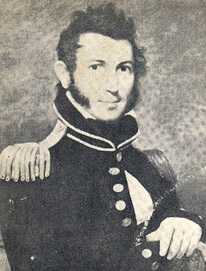John M. Gamble
| John M. Gamble | |
|---|---|
 | |
| Born |
1791 Brooklyn, New York |
| Died |
11 September 1836 (aged 44–45) New York City |
| Allegiance |
|
| Service/branch |
|
| Years of service | 1809 |
| Unit | USS Essex |
| Commands held |
Greenwich Sir Andrew Hammond Fort Madison |
| Battles/wars | |
| Other work | Artist |
Lieutenant Colonel John Marshall Gamble (1791 – 11 September 1836) was an officer in the United States Marine Corps during the early 19th century. He was the first, and remains the only, U.S. Marine to command a U.S. Navy ship, commanding the Greenwich and the Sir Andrew Hammond during the War of 1812.[1][2]
Biography
Born in Brooklyn, New York, Gamble was appointed Second Lieutenant on 16 January 1809.
He held the rank of captain and was stationed in the South Sea during the War of 1812.[3] He distinguished himself in many enterprises, including encounters with people of the Marquesas Islands during the absence of frigate Essex in 1813, and sailing a prize of Essex, with only a four-man crew and without benefit of a chart in a 17-day voyage to the Hawaiian Islands.
Captain Gamble is remembered in history as one of the two U.S. Marines to command U.S. Navy ships. He was the only U.S. Marine to engage in a naval duel with another ship of equal size and prevail. His capture of the British armed whaler Seringapatam was noted as a triumph by American newspapers and thus earned him considerable fame upon his return. The Seringapatam was deemed as the biggest British threat to American whalers in the S. Pacific at the time.
On the 14th of July, 1813, Commodore Porter wrote of Lieutenant Gamble : " Allow me to return to you my thanks for your handsome conduct in bringing the Seringapatam to action, which greatly facilitated her capture, while it prevented the possibility of her escape. Be assured, sir, I shall make a suitable representation of the affair to the honorable Secretary of the Navy."
Commodore Porter wrote a further communication to the Navy Department which went as follows: " Captain Gamble at all times greatly distinguished himself by his activity in every enterprise engaged in by the force under my command, and in many critical encounters by the natives of Madison Island, rendered essential services, and at all times distinguished himself by his coolness and bravery. I therefore do, with pleasure, recommend him to the Department as an officer deserving of its patronage." And again he wrote: "I now avail myself of the opportunity of assuring you that no Marine officer in the service ever had such strong claims as Captain Gamble, and that none have been placed in such conspicuous and critical situations, and that none could have extricated themselves from them more to their honor."
The decision to burn the Greenwich at Nuku Hiva also served to deprive the British of the valuable whale oil, then badly needed in England. His subsequent capture by the British sloop Cherub, also served to protect the American whaling efforts in the region. Aboard the Sir Andrew Hammond, Gamble was carrying gifts to be delivered as a tribute to the king of the Leeward Islands. When these were taken by Capt. Tucker of the Cherub as prizes of war, the diplomatic relations between the British and king of the Leeward Islands deteriorated. When American whalers were seen in his harbor, Tucker demanded the native king to turn them and the stockpiled whale oil over to him. Tucker went so far as to threaten the king of landing his Royal Marines in order to change his mind. The good king firmly said "No". Tucker's knew a sloop's complement of marines and firepower would be a useless effort and thus sailed away.
He was breveted a lieutenant colonel on 3 March 1827.
He died in New York City on 11 September 1836.
Namesake
The destroyer USS Gamble (DD-123) was named for him and his brother, United States Navy Lieutenant Peter Gamble.
Galleries and Public Collections
- John Gamble Gallery of Art – Laguna Beach, California
See also
Notes
- ↑ "The Month of July in American Naval History". U.S. Fleet Forces, United States Navy. Retrieved 10 May 2009.
July 14, 1813 – LT John M. Gamble, the first marine to command a ship in battle (prize vessel Greenwich in capture of British whaler Seringapatam)
- ↑ Gibowicz, Charles J. (2007). The Traditions: Marine Corps Mess Night Tradition. Mess Night Traditions (AuthorHouse). p. 18. ISBN 978-1-4259-8446-5. Retrieved 11 May 2009.
...one U.S. Marine is on record as having a command not since duplicated....On 30 March 1813, Lt. John M. Gamble, USMC, assumed command of the USS Greenwich, the only Marine ever to command a U.S. Navy ship.
- ↑ "Marine Corps Officers of the War of 1812". Wars and Conflicts of the United States Navy. Naval History & Heritage Command, Department of the Navy. Retrieved 10 May 2009.
References
- This article incorporates text from the public domain Dictionary of American Naval Fighting Ships.
- "Gamble". Dictionary of American Naval Fighting Ships. Naval History & Heritage Command, Department of the Navy.
Chapter Semper Fidelis, "Gamble of the Marines" by Capt. Raymond Toner USN.
Further reading
- Gamble, John M. (1828). The memorial of Lieut. Colonel J.M. Gamble, of the United States' Marine Corps, to Congress, 1828. New York: Geo. F. Hopkins & Son. Retrieved 10 May 2009.
- Toner, Raymond J. (2007). Martin, Iain C., ed. Gamble of the Marines. The Greatest U.S. Marine Corps Stories Ever Told (Globe Pequot). pp. 13–20. ISBN 978-1-59921-017-9.
|